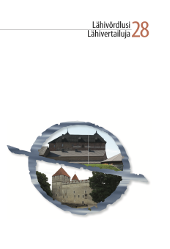Suomen sijamuotojen nimitykset: kuinka käsiteanalyysi ja tuotekehittely 1800-luvun kieliopeissa saataisiin hyödyttämään S2- ja äidinkielen opetusta?
On the naming system of the Finnish nominal cases: Concept analysis and product development in the 19th century Finnish grammars
Author(s): Maria KokSubject(s): Morphology, Historical Linguistics, Finno-Ugrian studies, 17th Century, 18th Century, 19th Century
Published by: Eesti Rakenduslingvistika Ühing (ERÜ)
Keywords: L2 Finnish learning; L1 Finnish learning; case system of Finnish; Finnish local cases; grammatical terminology; history of grammar tradition;
Summary/Abstract: This study discusses the naming system for the Finnish nominal cases as a terminological product and the research material is a collection of 17th–19th century grammars of the Finnish language. According to the findings, it can safely be concluded that most of our terms for the Finnish nominal cases originate from the 19th century. Te term systems used to describe the Finnish nominal cases changed many times before the current terminology was accepted as official. Te development process that leads to the terminology we have now has been long but cannot be called gradual. On the contrary, most changes in the terminological system were abrupt and may be considered conscious choices of individual scholars. Special attention in this study is given to the term system used to denote the six Finnish local cases: inessive, elative, illative, adessive, ablative and allative. This system is currently applied in most reference grammars and standard works for studying L1 and L2 Finnish and it can rightfully be attributed to Gustav Renvall (1840). Not only was this system used for the first time by Renvall, but in his grammar “Finsk Språklära Enligt den rena VestFinska” Renvall also takes credit for the new terms and gives a lengthy account of their structure and meaning. Renvall also argues why his terms should be used instead of those suggested by i.e. Vhael (1733) and von Becker (1824). From a conceptual analytical point of view, Renvall’s terms pass scrutiny on many levels. Te terms are by no means incorrect or misleading. Each of them gives valid information about the meaning and use of the respective case. They also are innovative and original: only “ablative” has been used in previous grammars. Te other five terms are all new and tailor-made in order to describe the core meanings of the Finnish local cases. In the language learning context, however, Renvall’s terms appear to be problematic. They are based on Latin prepositional verbs, which may have been a helpful feature during Renvall’s lifetime but has become a disadvantage in modern-day classroom usage. Especially in L1 and L2 Finnish on the elementary level, there is a need for alternative or parallel terminology that is not only accurate but also user-friendly. A good starting point for further development might be to utilize the term system of Reinhold von Becker which is not without merits, although it was set aside shortly after Renvall’s grammar appeared. Practical experience of all who teach Finnish on any educational level will probably be of great value as well.
Journal: Lähivőrdlusi. Lähivertailuja
- Issue Year: 2018
- Issue No: 28
- Page Range: 143-177
- Page Count: 35
- Language: Finnish

